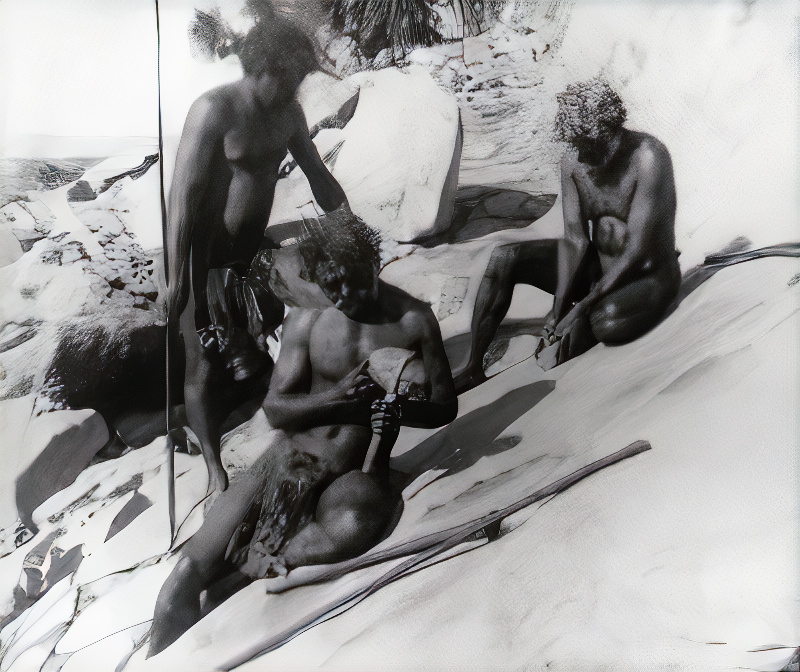ABOUT THIS WEBSITE AND DAVID M. WELCH
This website originated in 2006, written and created by Dr David M. Welch in order to educate students, teachers and the general public on the basic aspects of Australian Aboriginal culture. It has been visited by tens of thousands of school and university students over the past decade, providing material for study projects and those seeking a greater understanding of Australia’s ancient culture.
The site looks at how Aboriginal culture was at the time of European arrival, when Australia was composed of more than 400 tribes or language groups, similar to Europe comprising a number of different countries. Australia’s landscape varies from rainforests to deserts, from coastal and marine environments to an arid interior. Subsequent variations in vegetation and food resources have shaped the nature of Aboriginal culture, which varies throughout the continent. People from different regions have different languages, weaponry, utensils, tools, basketry, art styles, ceremonial dress, and beliefs in their Ancestral Beings.
Aboriginal culture has evolved over time. Archaeological and rock art research reveals developments in stone tool technology, the introduction or invention of the spearthrower possibly 10,000 years ago, and evolving religious beliefs. Since the visitation of Macassan (Indonesian and Malay) fishermen after 1700 AD, and later European colonisation in 1788, Aboriginal culture has further developed and changed.
This website includes material from the Australian Aboriginal Culture Series, also produced by David M. Welch. This is a collection of books relating to Aboriginal studies, including works by the early ethnographers Herbert Basedow, Baldwin Spencer and J. R. B. Love. Recent additions to the series include books on the Aboriginal paintings of the Kimberley (in north Western Australia) and Kakadu National Park (in the Northern Territory).
Dr David M. Welch is a general medical practitioner based in Darwin in the Northern Territory of Australia, who has worked with Aboriginal people since the 1970s, researched their rock art (painted shelters and engraved rocks) and other aspects of their culture, and written more than thirty journal articles, reports and books on the subject. The journal articles can be found and downloaded at www.davidmwelch.com.au.
Research includes the documentation of nearly 2,000 Kimberley (north Western Australia) Aboriginal rock art sites and the unearthing of chronological sequences for Kimberley rock art announced in 1990 and 1992. Current research includes field work on Groote Eylandt (a part of Arnhem Land, Northern Territory, situated in the Gulf of Carpentaria) where a systematic survey of rock paintings and archaeological sites is being undertaken, in conjunction with Traditional Owners, the Anindilyakwa Land Council, and other researchers.
Other work by David M. Welch includes the compilation, editing and publication of the biographies of Reggie Sultan (an Aboriginal artist), Judy Opitz (who set up the first general store in what is now Kakadu National Park) and Dick Dakeyne (a World War Two veteran who served near Darwin).
INTRODUCTION TO AUSTRALIA'S ABORIGINAL CULTURE
Australia’s Aboriginal culture probably represents the oldest surviving culturein the world, with the use of stone tool technology and painting with red ochre pigment dating to at least 50,000 years ago…

REGIONAL VARIATIONS
Australia’s landscape varies from rainforests to deserts, from coastal and marine environments to an arid interior. Subsequent variations in vegetation and food resources have shaped the nature of Aboriginal culture, which varies throughout the continent…
RELIGION
Aboriginal religion, like other religions, is characterised by having a god or gods who created people and the surrounding environment during a particular creation period at the beginning of time…
SOCIAL ORGANISATION
Aboriginal people have complex social and marriage laws, based on the grouping of people with their society. The social fabric of Aboriginal society is maintained in the remote parts of central and northern Australia, and the present tense is used to describe these features…

ART
Aboriginal art is integral to the culture, and often inspired by religious and ceremonial aspects of life. Here are summaries of situations where painted and engraved art have been applied in traditional times, other art forms, and an overview of the main styles of Aboriginal art…

Basketry
Aboriginal women utilise a range of bags, baskets and containers to carry food and other items…

Body Adornment
We all like to dress up and look our best amongst friends and family, and Aboriginal people are no different…

Bush Foods
A wide range of plants and animals were eaten by Australia’s Aborigines, and insect foods included certain ants, grubs, moths and beetles, while streams provided fish and eels (in some regions). Birds were eaten, including waterfowl, scrub fowl, the cassowary and the jabiru.

Ceremonial Life
To this day, ceremonies play an important part in Aboriginal life. Small ceremonies, or rituals, are still practised in some remote parts of Australia, such as in Arnhem Land and Central Australia, in order to ensure a supply of plant and animal foods…

Fishing
In addition to land animals and plants, Aboriginal people hunt and fish a range of marine and freshwater species. Coastal people hunt sharks, dolphins, rays, turtles and marine fish…

Fire Making
At the time of European contact, Australian Aborigines made fire using four methods. These were…

Housing and Shelters
Australian Aborigines were nomadic people, hunting and food gathering as they travelled within their tribal boundaries. They made semi-permanent stops, camping for days or weeks in one place, depending on the availability of food and water.

Stone Tools
Stone tools were used to cut wood and bark from trees, to fashion wooden tools, weapons and utensils, and to pound and grind food.

Tree Climbing
People climbed trees for a number of reasons. To catch possums, lizards, snakes and other native animals…

Wooden Tools and Weapons
Australian Aborigines manufactured a range of tools, utensils, fighting weapons, and hunting weapons made from the available resources of wood, bone and shell…
